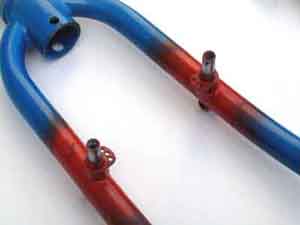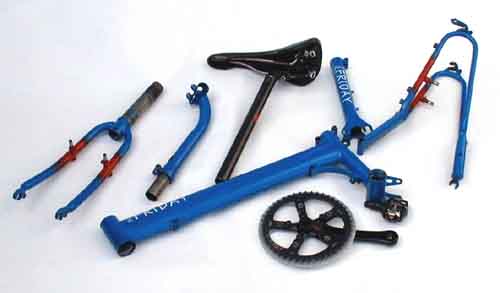More about brakes - fitting V-brakes
By Peter Evans
Older models of the New World Tourist have calliper brakes of various
kinds In my case the model I acquired was fitted with Dia-Compe FSS. The
front worked well but the rear brake was very poor. Ever since losing both
brakes on a steep hill many years ago I have always thought that a bike
should be stoppable with one brake even when fully loaded with camping
gear. I tried various ways of improving the rear brake’s power, most
of which seemed to be lost in trying to straighten the sharp curves taken
by the cable. The stopping power was improved when these curves were done
away with and the cable allowed to take an almost straight run to the
brake - but the bike would not fold. A development of this would be to
make the brake cable long enough to fold but running it from the brake
lever to the brake without using the cable stops and just lightly
attaching it to the frame with plastic ties.
A further improvement was obtained when the only other long reach brake
I could find, the Dia-Compe Big Dog, was fitted. But it still did not
provide the required stopping power, as I like to ride on the bar ends and
use brake lever extensions. Brake extension levers reduce the power that
can be applied and work best with V-brakes.
I decided to strip the bike down and have V-brake studs brazed on. My
local bike shop said that if the studs were fixed by silver soldering
damage to the paint work would be limited. Stripping the bike was
straightforward until it came to separating the rear forks from the bottom
bracket. Having undone the two allen bolts in the hinge that allows the
bike to fold, there was no obvious way to remove the hinge pin. It looked
as though it could be knocked out, but refused to budge when tapped.
One of Green Gear’s merits (for those with internet access) is
their on-line help to community members. A message was posted in the Tech
Talk list and Wolfgang Morritz came back to advise soaking the hinge pin
with penetrating oil for two days. He went on to say “the hinge pin
is hollow and threaded at both ends for the end bolts. Reinstall one of
the bolts and with either a 4mm allen wrench or some other punch, slip the
punch through the other open end and hammer against it so it pushes
against the bottom of the bolt. When you do this be careful not to deform
the bottom of the hinge plate that is brazed to the bottom bracket shell.
Support the hinge as much as possible so it does not bend.”
I followed these instructions with no visible result, but at some stage
something moved enough for the two parts to separate. When the forks came
back from having the studs brazed on the paint - in the colour known as ‘near
chrome’ - was burnt about two inches either side of the studs. Unable
to match this colour, I applied a contrasting black gloss using
Plasti-kote from a spray can. This paint dries in about an hour so that it
is possible to apply five or six coats in a day to build up thickness.
The V-brakes fitted were Shimano BMX type, chosen because, being
finished in red, I hoped they would match the red of the NWT: no match,
but near enough.
 Bike
Fridays can give a very harsh ride at times so to improve on this a
Softride stem was added together with a suspension seatpost from Ultimate
Sports Engineering. The result is a comfy, reasonably light bike with
excellent load carrying capability when both front and rear carriers are
fitted, and which can be used for fast road touring or off-road camping.
Bike
Fridays can give a very harsh ride at times so to improve on this a
Softride stem was added together with a suspension seatpost from Ultimate
Sports Engineering. The result is a comfy, reasonably light bike with
excellent load carrying capability when both front and rear carriers are
fitted, and which can be used for fast road touring or off-road camping.
 The pictures show Mike Hessey's NWT which is currently undergoing a
conversion to V brakes, to be followed by a respray.
The pictures show Mike Hessey's NWT which is currently undergoing a
conversion to V brakes, to be followed by a respray.
Return to Newsletter 2 contents |
Return to main brakes page |
Return to home page | Return
to User Group UK page |
Go to Bike Friday USA web
site
Last updated: 7 March 1999
Copyright (C)1999 Ferrets Anonymous
 Bike
Fridays can give a very harsh ride at times so to improve on this a
Softride stem was added together with a suspension seatpost from Ultimate
Sports Engineering. The result is a comfy, reasonably light bike with
excellent load carrying capability when both front and rear carriers are
fitted, and which can be used for fast road touring or off-road camping.
Bike
Fridays can give a very harsh ride at times so to improve on this a
Softride stem was added together with a suspension seatpost from Ultimate
Sports Engineering. The result is a comfy, reasonably light bike with
excellent load carrying capability when both front and rear carriers are
fitted, and which can be used for fast road touring or off-road camping.
 The pictures show Mike Hessey's NWT which is currently undergoing a
conversion to V brakes, to be followed by a respray.
The pictures show Mike Hessey's NWT which is currently undergoing a
conversion to V brakes, to be followed by a respray.